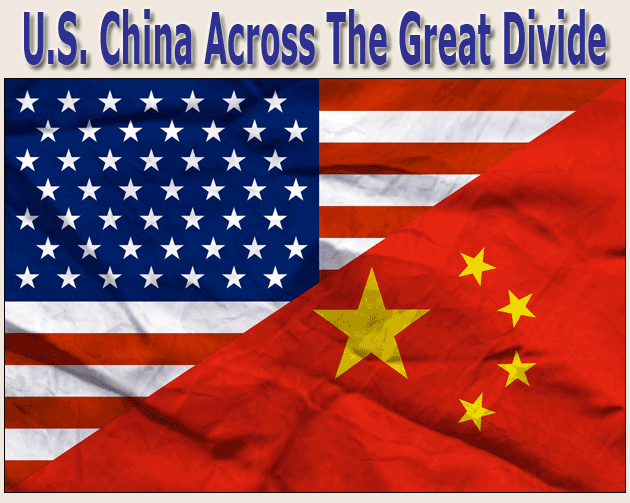 |
The brace of powerful USA aircraft
carriers on maneuvers in the South China Sea (SCS) in the past weeks sends
a powerful message to China that the U.S. and others will not be driven
off the waters that the CCP has been treating recently as its own private
lake.
The implications for trade are
underscored as SCS drives USD$7 trillion in trade annually.
But in broader thinking , push
has finally come to shove.
If we exclude any type of armed
conflict, which for two countries the size and technical sophistication
of the United States and China would truly be catastrophic, the objectives
and field of conflict become rather clear.
What is going on in 2020 is
an economic and world view conflict between a closed authoritarian state
and open liberal democratic systems of governance.
Specifically, how this heightened
tension between the two top world economies impacts overall trade remains
an open question.
 “One thing for certain,”
a source told me, “the COVID-19 development has opened up eyes and
thoughts about China around the world and there is no going back.” “One thing for certain,”
a source told me, “the COVID-19 development has opened up eyes and
thoughts about China around the world and there is no going back.”
In addition to the lockdown
now entering its fifth month, there has been a lot going on in all things
China lately.
As Professor Christopher Balding, (right) a China
expert at the Fulbright Institute, notes:
“Since the ascendance
of Great Leader Xi in late 2012, China has made no secret of its muscular
foreign policy from the South China Sea to Uyghurs in Xinjiang and to
economic and industrial warfare around the world.”
Long Time Coming
“This strain of Chinese
foreign policy began well before President Trump and will outlast a one
or two-term President Trump.
“The conflict with China
is not due to needing better communication or better understanding.
“The reality is that the
policies that China is executing now have been planned and discussed clearly
for years. Xinjiang, Taiwan, South China Sea, economic protectionism,
Hong Kong, techno-authoritarianism, are clearly stated objectives by China
across a variety of institutional formats that have been discussed widely
within formal governmental forums and permissible propaganda type forums.
“To argue that the current
escalated conflict is due to poor communication between the USA and China
is nothing less than staggering ignorance about what China has stated
clearly and repeatedly as its objectives.”
Careful Consideration Planned
“Official and unofficial
China has thought long and hard about their preferred policy path and
have the agency to make their own decisions about how to proceed.
“Most people at the beginning
believed this was a simple trade dispute between China and the United
States, “ Christopher Balding said.
Fundamental Values
“The conflict between
China and the United States is a fundamental conflict between the values
of open liberal democracy with human rights, and free markets at its core
versus the closed authoritarian state-centric governance system of China.”
China & The World
“This is not a conflict
about specific policies,” Balding notes, “but rather about
an entire system of human governance.
“We are afforded a couple
of principles moving forward about how to frame this conflict.
“First, openness and engagement
is relatively pointless with the objective to change Chinese government
policy.
“Openness is good and
useful policy across many policy domains and it still should be pursued
pretty generally, but we must realize it has little to no impact on changing
Chinese government policy in a range of areas that would fit U.S. government
satisfactory policy sets or ranges.”
For Example
“If openness and engagement
with China actually changed Chinese government policy in the general direction
of the U.S. or developed country democracy acceptable sets, the past 20
years would have yielded vastly different outcomes than where we currently
stand.”
“If anything, the generalized
policy of openness and engagement towards China has been shown to produce
the opposite of its claimed outcome.”
“A common argument is
that better communication or negotiation strategies will give the U.S.
influence.
“However, the CCP will
never negotiate its authoritarian stranglehold on China willingly,”
Professor Balding declared.
Cold War 2.0
“We are entering Cold
War 2.0.” Professor Balding claims the new landscape will require
United States competing and challenging China across virtually every policy
domain about how best to project liberal open democratic, human rights,
free market vision on to the world.
“Whether this is new international
institutional arrangements or competing telecommunications standards or
development funding for lesser developed countries, the United States
must be prepared to challenge and compete with China across every policy
domain.
“The United States has
been waking up to these challenges and is moving to address them but an
enormous amount of work remains ahead,” Christopher Balding declared.
Choosing Up Sides
“We can already see evolving
soft alliances with China surrounding itself with DPRK, Iran, Syria, and
other authoritarian states and building up other authoritarian states
as well.
“This framework provides
a few clear implications for the USA and others, on how to approach the
China challenge.
“Just as China has built
its own salad bowl of bilateral and multilateral institutions, the United
States must challenge and compete with China, whether in Asia or Latin
America to work with countries that aspire to the same values.
Challenging Situation
“The USA must ‘challenge’
countries that align themselves with China, just as it took issue with
allies funding the Soviet Union in the Cold War.
Across The Great Divide
“We have crossed the Rubicon
and China has laid bare their intentions.
“We cannot return to the
days of blissful ignorance when the learned could feign ignorance on the
goals, objectives, and intentions of China.
“That’s the reality.
“This is the conflict,”
Professor Christopher Balding declared.
Geoffrey
|




